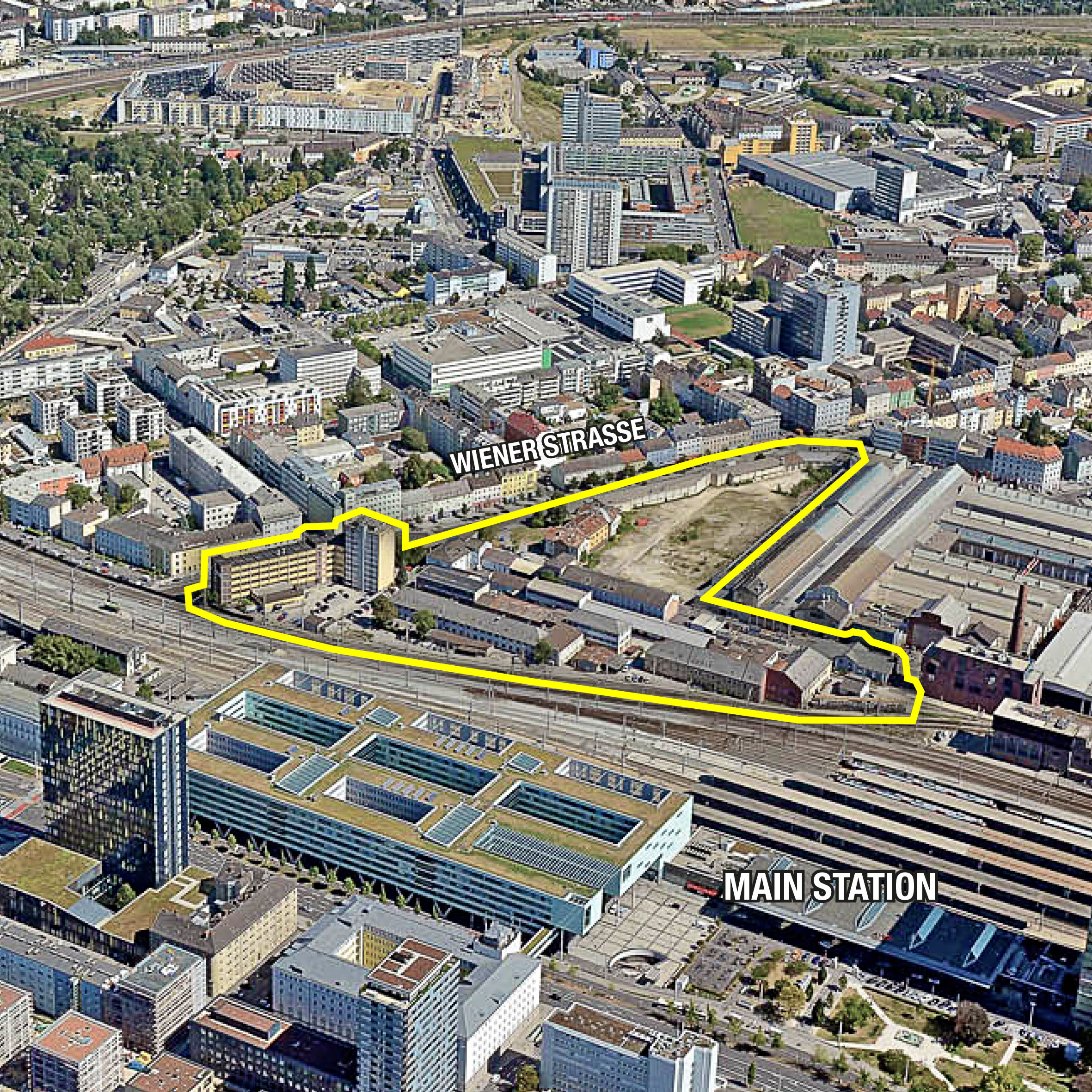Linz (AT)
The Synthetic Site Folder and Site Brief are available for free.
Please register and login to access the Complete Site Folder.
- Synthetic site folder EN
- Site Brief EN
- Site on Google Maps
- Back to map
Data

Project Scales L/S - Urban and architectural
Location Wiener Straße, Linz
Population 204,000 inhab.
Strategic site 110 ha – Project site 3.91 ha
Site proposed by ÖBB (Austrian Railways) and the City of Linz
Actors involved ÖBB (Austrian Railways) and the City of Linz
Owner of the site ÖBB(Austrian Railways)
Post-competition phase Strategic urban concept as a base for further development steps
Team representative Architect, urban planner
More Information
How can the site contribute to the productive city?
Exploiting the site's potential as a future link between the historical core and Linz-South will considerably change the identity and performance of the whole main-station area. Combining high accessibility with a productive mix of uses in dialogue with the station's potential will multiply the site's role as a future North-South-connector.
The site is already productive –with workshops to maintain and update railway carriages. But it operates as a monofunctional enclave, reinforcing the station's barrier-effect. The owner, the ÖBB (Austrian Federal Railways), intends to move the existing production outside the city in order to develop an urban neighbourhood with mixed uses. A key challenge is to integrate new forms of productive economies, preserving the site as a place for work and production to keep productive jobs within the city.
City strategy
The transformation and integration of industrial enclaves into the urban fabric is a main strategy for inner-city growth. To reach a higher level of permeability along infrastructural barriers contributes to the reduction of isolated and disadvantaged areas, enabling exchange between adjacent neighbourhoods. A special goal is to decrease the barrier effect of the main station, providing better North-South connections for pedestrians in order to interrelate the administrative and cultural districts nearby and to establish an attractive route towards the centre. To the South as well as to the East the site will have to start a communication with the existing mixed used perimeter block neighbourhoods.
Site definition
With a size of 38,000 sqm, at the edge between the inner city and the district of Bulgariplatz, the site has the enormous capacity to re-orientate the main station, making it a “bridge“ between North and South. Being limited by the railway lines (North-West) and the production zone of the ÖBB-Technical Service (South-West), the main access is situated along Wienerstrasse (North-East), providing a tramline that runs underground in this area (“mini-subway“). The tramway stop on the site's South-West-corner has the highest frequency of public transport passengers in Linz! An internal road (access from Wiener Straße) divides the site into a Northern and Southern zone. Workshops and warehouses, holding different technical functions (relocation intended), and a rundown living tower occupy the North, whereas the Southern zone is mainly vacant (first phase of implementation).
How is Production Considered in the Urban Diversity Program?
The project has to create an attractive high-density development with a high degree of mix, facing the challenge of considerable noise and strong barriers. Therefore, the way of distributing programs in dialogue with a special configuration of intelligent typologies is key for a successful new neighbourhood.
Due to the environmental attributes the Northern part of the site shall be dedicated to productive economies where all variations of urban forms of craft could be implemented in coexistence with a regional headquarter of the ÖBB. First step will be to frame innovative concepts and to evoke programmatic synergies with the neighbouring functions, especially with the railway/station-infrastructures and the existing production units. New spatial typologies and strategies for integration of inventive urban formats of production should be sketched. Highly adaptable structures should inspire for various combinations and dimensions of manufacturing workspaces, allowing to transform over time, as well as to open towards the outside, especially in the area of the ground floor where the programs should be directly linked to public space. In the Southern area, different forms of commercial programs and new facilities for shopping along the Wiener Straße shall be developed. Housing shall be integrated only to a certain extent, considering the special location (programme, contamination).
Questions on the site
Hi, could we have a 3d model of the site please? Thanks,
For the 3D information please check the file: AT-LINZ-PS-M7.dxf uploaded on the 21.04.17.
This site is connected to the following theme
And productive again! How to Reintroduce the Productive Economy into New Urban Districts? Many formerly industrial places in and around cities are now out of use. Buildings were left in a derelict state, activities have been moved or stopped, sites became brownfields. Obsolescence is the common feature of these sites and the future is uncertain. Mostly, we dream of turning them into new vibrant urban quarters. But to avoid total gentrification as it has appeared many urban renewal projects in the past, we should perhaps try to put some productive activity in these sites… again? Because these sites were once industrial and linked to the city. Because there is a will for a really mixed city, and that mix includes productive economy as well.
How to Reintroduce the Productive Economy into New Urban Districts?
Questions on the site
You have to be connected –and therefore registered– to be able to ask a question.
Fr. 16 May 2025
Deadline for submitting questions
Fr. 30 May 2025
Deadline for answers
Before submitting a question, make sure it does not already appear in the FAQ.
Please ask questions on sites in the Sites section.
Please ask questions on rules in the Rules section.
If your question does not receive any answer in 10 days, check the FAQ to make sure the answer does not appear under another label or email the secretariat concerned by the question (national secretariat for the sites, European secretariat for the rules).